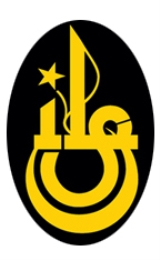
Istanbul Lisesi
Encyclopedia
İstanbul Lisesi, also commonly known as İstanbul Erkek Lisesi, abbreviated İEL, is one of the oldest and internationally renowned high school
s of Turkey
. The school is considered elite among Turkish public high schools. Germany recognizes the school as a Deutsche Auslandsschule (German International school).
İstanbul Lisesi is located in Cağaloğlu, İstanbul
. The school has changed several buildings throughout its history. Since 1933 the school has used its current building. The building was designed by architects Alexander Vallaury
and Raimondo D'Aronco and inaugurated in 1882 as the Düyun-u Umumiye (Council of Ottoman Revenues and Debts Administration
) Building, which overlooks the entrance to the Bosphorus and the Golden Horn
. A new building adjacent to the main historical building was inaugurated in 1984, providing new boarding and sports facilities. The primary languages of instruction are Turkish
and German
. The secondary foreign language of instruction is English
.
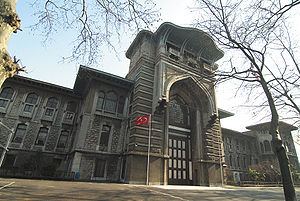 As a state school, admissions to İstanbul Lisesi are through the Secondary Education Institutions Entrance Exams (OKS
As a state school, admissions to İstanbul Lisesi are through the Secondary Education Institutions Entrance Exams (OKS
), the central state school examination. İstanbul Lisesi is one of the most difficult schools to enter of all the 400 Anadolu Lisesis (special state secondary schools) in the country. Admission to the İstanbul Lisesi requires a tough competition, since only 180 students out of 1,400,000 applicants can make it through every year, and İstanbul Lisesi is usually among the first choices of best ranked students along with Galatasaray High School and leading Fen Lisesis (Science high school).
The school offers a tuition-free, high level education, providing voluntary boarding possibilities, and as such, draws a diverse group of students from all over Turkey
, including students who cannot afford private education. The academic program enables students to pursue academic excellence and acquire fluency and literacy in German and Turkish.
İstanbul Lisesi is the first Turkish school
The education period is five years (one year German preparatory, and four year high school). The German Abitur
has been offered at İstanbul Lisesi since 2000. The Abitur diploma permits successful students the admission to any German university in almost any faculty. All science and mathematics courses in the last two years are at Abitur level. İstanbul Lisesi has a very strong academic record, with a high proportion of its students proceeding to prominent universities in Turkey
, Germany
, Austria
and the United States
.
Since 1999 İstanbul Lisesi has been a 5-year school. All students are required to spend their first year learning to master the German language, taking twenty-three hours of instruction in their first year and eighteen hours in their second year. Science, mathematics and English courses also start in the preparatory class. Biology is the first science class followed by physics and chemistry in the ninth and tenth grades (second and third years, respectively).
In the eleventh grade the students choose between two majors: Mathematics and Sciences (FEN), or Turkish and Mathematics (TM). Students who aim to pursue careers in engineering, sciences or medicine, major in FEN, concentrating on science and mathematics courses. TM major is dominated by courses in social sciences and mathematics and is for students who want to study humanities, business, economics or social sciences.
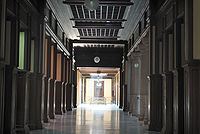 The academic standards are demanding, and the grading system is strict. As the school follows both German and Turkish curricula, two evaluation scales are used. The grade equivalents in the Turkish evaluation are:
The academic standards are demanding, and the grading system is strict. As the school follows both German and Turkish curricula, two evaluation scales are used. The grade equivalents in the Turkish evaluation are:
A GPA of 2.0 is a passing grade, 3.5 is honors, 4.5 is high honors.
In the German Department student grades are evaluated on a 15 scale:
Both systems do not use weighted grades as the U.S. system does. The weight of the grade of a subject depends on the hours of classes the subject is taught per week.
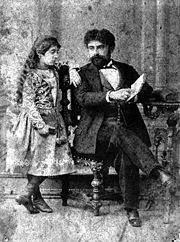 Mehmet Nadir Bey
Mehmet Nadir Bey
, a retired Captain of the Navy, a prominent mathematician and teacher, together with Selanikli Abdi Kamil Efendi, a school principal, founded in 1882 the first private school in İstanbul, the Şems’ül Maarif (The Sun of Education), but for unknown reasons the partnership did not last long.
Mehmet Nadir Bey established his own private school Numune-i Terakki (The Example of Progress) in 1884, which would be the foundation of İstanbul Lisesi. At the beginning, the school provided primary and middle school education for boys, but would soon add high school classes, and also start accepting girls. In an interview to a newspaper in 1891, Mehmet Nadir Bey would express his pride to have established the first private high school in Turkey. The school would not only attract many students in a short time (the number of students would reach 600 in 1891, of which 150 were boarding students), but also catch the attention of the Ministry of Education, and of the Sultan himself.
After the detection of some teachers’ involvement in an unsuccessful coup to overthrow Abdülhamid II, the school was purchased by the Ministry of Education in 1896, which changed its name to Terakki İdadisi (Progress High School). From 1896 to 1908, the school became a day school, changed several buildings, and according to the facilities occupied, varied in size and number of students. Following the move to a larger building and the legislation combining the 4-year primary school and 3-year middle school into a 5-year education, the school was able to provide boarding again in 1908, and the name of the school was changed to İstanbul Leyli İdadisi (Istanbul Boarding High School) in 1909.
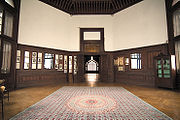 In 1910, the school started to use the word Lise (Lyceum), a first in a Turkish school. İstanbul Lisesi was a 5-year boarding school charging tuition, and was admitting students following an examination. The physical education teacher of the school, Abdurrahman Roberson, established İstanbulspor and a boy scout group in 1912. The scout group, later named Sakarya in honor of the Turkish victory in Battle of Sakarya
In 1910, the school started to use the word Lise (Lyceum), a first in a Turkish school. İstanbul Lisesi was a 5-year boarding school charging tuition, and was admitting students following an examination. The physical education teacher of the school, Abdurrahman Roberson, established İstanbulspor and a boy scout group in 1912. The scout group, later named Sakarya in honor of the Turkish victory in Battle of Sakarya
, is still active to this day. Also in 1912, during the First Balkan War
, about 30 students volunteered for the defense of the capital against the advancing Bulgarian army.
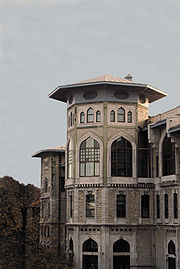 The school name was changed to İstanbul Sultanisi (Istanbul High School) in 1913. Following the closing of the foreign schools in İstanbul due to the beginning of the First World War, İstanbul Sultanisi was moved to the buildings of the Saint Benoit High School, and some parts of the buildings were changed to dormitories. The faculty was supported with the addition of prominent teachers, and the student populace exceeded 1600. Subsequent to the increased collaboration between the German and Ottoman Empires, 22 German teachers were sent by the German Ministry to the school, and the curriculum was changed to German. The curriculum was similar to Galatasaray High School, only the foreign language was German instead of French. The students would take 14 hours of weekly lessons in German, and the same lectures again in Turkish, except history and literature, which were taught only in Turkish.
The school name was changed to İstanbul Sultanisi (Istanbul High School) in 1913. Following the closing of the foreign schools in İstanbul due to the beginning of the First World War, İstanbul Sultanisi was moved to the buildings of the Saint Benoit High School, and some parts of the buildings were changed to dormitories. The faculty was supported with the addition of prominent teachers, and the student populace exceeded 1600. Subsequent to the increased collaboration between the German and Ottoman Empires, 22 German teachers were sent by the German Ministry to the school, and the curriculum was changed to German. The curriculum was similar to Galatasaray High School, only the foreign language was German instead of French. The students would take 14 hours of weekly lessons in German, and the same lectures again in Turkish, except history and literature, which were taught only in Turkish.
The Armistice of Mudros
, the subsequent occupation of İstanbul, and the incompetence of the government in İstanbul had important affects on the school. As the school was given only 2 days to evacuate the building by the commander of the occupying forces, most of the valuable library and the educational material had to be left behind. The school was not able to find a suitable building for a long time, and some students continued their education in different buildings, sometimes in different schools. Nonetheless, the faculty was still very strong and many of the teachers, such as Hasan Ali Yücel, Mazhar Nedim, Memduh Şevket Esendal, would become the prominent figures and/or leaders that contributed to the shaping of the society, ideological basis, and the governance of the Republic of Turkey. Some of the students and many alumni would join Atatürk in his struggle for independence at very early stages, and some would lose their lives during the battles.
With the declaration of the Republic, the school moved to the Fuat Paşa Mansion in Beyazıt and its name was changed to İstanbul Erkek Lisesi (Istanbul Boys' High School) in 1923. On Atatürk’s instructions, the school moved to the building of the former Düyun-u Umumiye (Council of Ottoman Revenues and Debts Administration) in 1933. During the Second World War the German education was suspended in 1942. Curriculum in German was introduced again in 1958 with the Bilateral Collaboration Agreement on Culture and Education between the Federal Republic of Germany and the Republic of Turkey. Last students of the regular high school curriculum would graduate in 1962, and the school started to admit girls in 1962, although the boarding was only provided to boys. The school remained a 7-year secondary school (1 year of preparatory, 3 years of middle school, and 3 years of high school).
The status of the high school was changed to Anadolu Lisesi, and the name was changed back to İstanbul Lisesi in 1982. In 1988 it gained a special status offering 2 year preparatory, 3 years of middle school, and 3 years of high school education. With the legislation on the extension of the compulsory primary school education from 5 years to 8 years in 2003, the education period was changed to 1 year German Preparatory and 4 year high school.
Republic
When all the 50 volunteered senior students fell during the Battle of Gallipoli
at Kabatepe, on May 19, 1915 at 3:30 am, the remaining students painted all the windows and the doors of the school in black in memoriam.
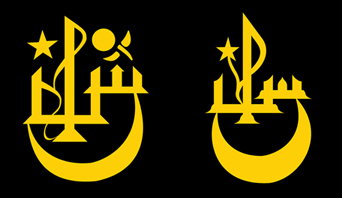
The first school emblem was designed in around 1915/1916. It incorporates the first letters of İstanbul Sultanisi, elif
and sin
in Arabic, a rose, the star, and the crescent. It was modified by the Turkish sculpturer Nejat Sirel (IS '07) in 1917. Sirel's design did not include the rose, whose symbolic meaning, if any, is still unclear.
The final form of the school emblem was designed by Orhan Omay (İEL '37) and has been in use since 1970.
For more information:
Day.
High school
High school is a term used in parts of the English speaking world to describe institutions which provide all or part of secondary education. The term is often incorporated into the name of such institutions....
s of Turkey
Turkey
Turkey , known officially as the Republic of Turkey , is a Eurasian country located in Western Asia and in East Thrace in Southeastern Europe...
. The school is considered elite among Turkish public high schools. Germany recognizes the school as a Deutsche Auslandsschule (German International school).
İstanbul Lisesi is located in Cağaloğlu, İstanbul
Istanbul
Istanbul , historically known as Byzantium and Constantinople , is the largest city of Turkey. Istanbul metropolitan province had 13.26 million people living in it as of December, 2010, which is 18% of Turkey's population and the 3rd largest metropolitan area in Europe after London and...
. The school has changed several buildings throughout its history. Since 1933 the school has used its current building. The building was designed by architects Alexander Vallaury
Alexander Vallaury
Alexander Vallaury was a French-Ottoman architect, who founded architectural education and lectured in the School of Fine Arts in Constantinople , Ottoman Empire....
and Raimondo D'Aronco and inaugurated in 1882 as the Düyun-u Umumiye (Council of Ottoman Revenues and Debts Administration
Ottoman Public Debt Administration
The Ottoman Public Debt Administration , was a European-controlled organization that was established in 1881 to collect the payments which the Ottoman Empire owed to European companies in the Ottoman public debt...
) Building, which overlooks the entrance to the Bosphorus and the Golden Horn
Golden Horn
The Golden Horn is a historic inlet of the Bosphorus dividing the city of Istanbul and forming the natural harbor that has sheltered Greek, Roman, Byzantine, Ottoman and other ships for thousands of...
. A new building adjacent to the main historical building was inaugurated in 1984, providing new boarding and sports facilities. The primary languages of instruction are Turkish
Turkish language
Turkish is a language spoken as a native language by over 83 million people worldwide, making it the most commonly spoken of the Turkic languages. Its speakers are located predominantly in Turkey and Northern Cyprus with smaller groups in Iraq, Greece, Bulgaria, the Republic of Macedonia, Kosovo,...
and German
German language
German is a West Germanic language, related to and classified alongside English and Dutch. With an estimated 90 – 98 million native speakers, German is one of the world's major languages and is the most widely-spoken first language in the European Union....
. The secondary foreign language of instruction is English
English language
English is a West Germanic language that arose in the Anglo-Saxon kingdoms of England and spread into what was to become south-east Scotland under the influence of the Anglian medieval kingdom of Northumbria...
.
Overview

OKS Turkey
OKS was the High School Entrance Examination in Turkey until 2007. It abbreviates "Ortaöğretim Kurumları Giriş Sınavı". It had 100 questions which were to be solved within 120 minutes and was mandatory for getting a place in a good high school in Turkey...
), the central state school examination. İstanbul Lisesi is one of the most difficult schools to enter of all the 400 Anadolu Lisesis (special state secondary schools) in the country. Admission to the İstanbul Lisesi requires a tough competition, since only 180 students out of 1,400,000 applicants can make it through every year, and İstanbul Lisesi is usually among the first choices of best ranked students along with Galatasaray High School and leading Fen Lisesis (Science high school).
The school offers a tuition-free, high level education, providing voluntary boarding possibilities, and as such, draws a diverse group of students from all over Turkey
Turkey
Turkey , known officially as the Republic of Turkey , is a Eurasian country located in Western Asia and in East Thrace in Southeastern Europe...
, including students who cannot afford private education. The academic program enables students to pursue academic excellence and acquire fluency and literacy in German and Turkish.
İstanbul Lisesi is the first Turkish school
- to offer private high school education (~ 1886)
- to publish the first student newspaper (before 1887)
- to use the title "Lise", equivalent of 'Lyceum' (1910)
- to provide German education to students (1912)
- to show a movie in the school (~1913) "Les Misérables", shown as "Jean’in Hikayesi" (Jean’s Story)
- to establish a student theater group (~1913) staging Abdülhak HamidAbdülhak HâmidAbdülhak Hâmid Tarhan was an early 20th century Turkish playwright and poet. He was one of the leading lights of the Turkish Romantic period...
’s “Eşber” and “Pinti Hamid” (L’avare), a MolièreMolièreJean-Baptiste Poquelin, known by his stage name Molière, was a French playwright and actor who is considered to be one of the greatest masters of comedy in Western literature...
adaptation by Teodor Kasap - whose students wore hats in İstanbul, following the announcement of the Reform of headgear and dressAtatürk's ReformsAtatürk's Reforms were a series of political, legal, cultural, social and economic reforms that were designed to modernize the new Republic of Turkey into a democratic and secular nation-state...
(1925).
The education period is five years (one year German preparatory, and four year high school). The German Abitur
Abitur
Abitur is a designation used in Germany, Finland and Estonia for final exams that pupils take at the end of their secondary education, usually after 12 or 13 years of schooling, see also for Germany Abitur after twelve years.The Zeugnis der Allgemeinen Hochschulreife, often referred to as...
has been offered at İstanbul Lisesi since 2000. The Abitur diploma permits successful students the admission to any German university in almost any faculty. All science and mathematics courses in the last two years are at Abitur level. İstanbul Lisesi has a very strong academic record, with a high proportion of its students proceeding to prominent universities in Turkey
Turkey
Turkey , known officially as the Republic of Turkey , is a Eurasian country located in Western Asia and in East Thrace in Southeastern Europe...
, Germany
Germany
Germany , officially the Federal Republic of Germany , is a federal parliamentary republic in Europe. The country consists of 16 states while the capital and largest city is Berlin. Germany covers an area of 357,021 km2 and has a largely temperate seasonal climate...
, Austria
Austria
Austria , officially the Republic of Austria , is a landlocked country of roughly 8.4 million people in Central Europe. It is bordered by the Czech Republic and Germany to the north, Slovakia and Hungary to the east, Slovenia and Italy to the south, and Switzerland and Liechtenstein to the...
and the United States
United States
The United States of America is a federal constitutional republic comprising fifty states and a federal district...
.
Curriculum
The school combines both German and Turkish curricula. Mathematics, geometry, chemistry, physics, biology, computer science and German classes are instructed in German, while history, geography, civic education, military sciences, religion, philosophy, literature, physical education, art and music are taught in Turkish. Textbooks, curricula and standards are under the permanent supervision of the German government. German and English are the compulsory foreign languages taught at İstanbul Lisesi.Since 1999 İstanbul Lisesi has been a 5-year school. All students are required to spend their first year learning to master the German language, taking twenty-three hours of instruction in their first year and eighteen hours in their second year. Science, mathematics and English courses also start in the preparatory class. Biology is the first science class followed by physics and chemistry in the ninth and tenth grades (second and third years, respectively).
In the eleventh grade the students choose between two majors: Mathematics and Sciences (FEN), or Turkish and Mathematics (TM). Students who aim to pursue careers in engineering, sciences or medicine, major in FEN, concentrating on science and mathematics courses. TM major is dominated by courses in social sciences and mathematics and is for students who want to study humanities, business, economics or social sciences.

| 5 | 4 | 3 | 2 | 1 | 0 |
| A | B | C | D | E | F |
| 100-85 | 84-70 | 69-55 | 54-45 | 44-25 | 24-0 |
A GPA of 2.0 is a passing grade, 3.5 is honors, 4.5 is high honors.
In the German Department student grades are evaluated on a 15 scale:
| 15 | 14 | 13 | 12 | 11 | 10 | 9 | 8 | 7 | 6 | 5 | 4 | 3 | 2 | 1 | 0 | |
| % | 94 | 89 | 84 | 79 | 74 | 69 | 64 | 59 | 54 | 49 | 44 | 39 | 34 | 27 | 19 | 0 |
Both systems do not use weighted grades as the U.S. system does. The weight of the grade of a subject depends on the hours of classes the subject is taught per week.
History

Mehmet Nadir
Mehmet Nadir was a Turkish mathematician and educationist- Early life :He was born in Sakız island then a part of the Ottoman Empire, to a poor family. He was adopted by a sea captain . He studied in the military high school in Bursa...
, a retired Captain of the Navy, a prominent mathematician and teacher, together with Selanikli Abdi Kamil Efendi, a school principal, founded in 1882 the first private school in İstanbul, the Şems’ül Maarif (The Sun of Education), but for unknown reasons the partnership did not last long.
Mehmet Nadir Bey established his own private school Numune-i Terakki (The Example of Progress) in 1884, which would be the foundation of İstanbul Lisesi. At the beginning, the school provided primary and middle school education for boys, but would soon add high school classes, and also start accepting girls. In an interview to a newspaper in 1891, Mehmet Nadir Bey would express his pride to have established the first private high school in Turkey. The school would not only attract many students in a short time (the number of students would reach 600 in 1891, of which 150 were boarding students), but also catch the attention of the Ministry of Education, and of the Sultan himself.
After the detection of some teachers’ involvement in an unsuccessful coup to overthrow Abdülhamid II, the school was purchased by the Ministry of Education in 1896, which changed its name to Terakki İdadisi (Progress High School). From 1896 to 1908, the school became a day school, changed several buildings, and according to the facilities occupied, varied in size and number of students. Following the move to a larger building and the legislation combining the 4-year primary school and 3-year middle school into a 5-year education, the school was able to provide boarding again in 1908, and the name of the school was changed to İstanbul Leyli İdadisi (Istanbul Boarding High School) in 1909.

Battle of Sakarya
The Battle of Sakarya , also known as the Battle of the Sangarios , was an important engagement in the Greco-Turkish War and Turkish War of Independence....
, is still active to this day. Also in 1912, during the First Balkan War
Balkan Wars
The Balkan Wars were two conflicts that took place in the Balkans in south-eastern Europe in 1912 and 1913.By the early 20th century, Montenegro, Bulgaria, Greece and Serbia, the countries of the Balkan League, had achieved their independence from the Ottoman Empire, but large parts of their ethnic...
, about 30 students volunteered for the defense of the capital against the advancing Bulgarian army.

The Armistice of Mudros
Armistice of Mudros
The Armistice of Moudros , concluded on 30 October 1918, ended the hostilities in the Middle Eastern theatre between the Ottoman Empire and the Allies of World War I...
, the subsequent occupation of İstanbul, and the incompetence of the government in İstanbul had important affects on the school. As the school was given only 2 days to evacuate the building by the commander of the occupying forces, most of the valuable library and the educational material had to be left behind. The school was not able to find a suitable building for a long time, and some students continued their education in different buildings, sometimes in different schools. Nonetheless, the faculty was still very strong and many of the teachers, such as Hasan Ali Yücel, Mazhar Nedim, Memduh Şevket Esendal, would become the prominent figures and/or leaders that contributed to the shaping of the society, ideological basis, and the governance of the Republic of Turkey. Some of the students and many alumni would join Atatürk in his struggle for independence at very early stages, and some would lose their lives during the battles.
With the declaration of the Republic, the school moved to the Fuat Paşa Mansion in Beyazıt and its name was changed to İstanbul Erkek Lisesi (Istanbul Boys' High School) in 1923. On Atatürk’s instructions, the school moved to the building of the former Düyun-u Umumiye (Council of Ottoman Revenues and Debts Administration) in 1933. During the Second World War the German education was suspended in 1942. Curriculum in German was introduced again in 1958 with the Bilateral Collaboration Agreement on Culture and Education between the Federal Republic of Germany and the Republic of Turkey. Last students of the regular high school curriculum would graduate in 1962, and the school started to admit girls in 1962, although the boarding was only provided to boys. The school remained a 7-year secondary school (1 year of preparatory, 3 years of middle school, and 3 years of high school).
The status of the high school was changed to Anadolu Lisesi, and the name was changed back to İstanbul Lisesi in 1982. In 1988 it gained a special status offering 2 year preparatory, 3 years of middle school, and 3 years of high school education. With the legislation on the extension of the compulsory primary school education from 5 years to 8 years in 2003, the education period was changed to 1 year German Preparatory and 4 year high school.
School Principals
Empire- Abdi Kamil Bey (1884–1885) & (1903–1904)
- Mehmet Nadir Bey (1885–1896)
- Numan Bey (1896–1897)
- Memduh Bey (1897–1900)
- Nadir Bey (1900–1903)
- Ziya Bey (1904–1906)
- Tevfik Danış Bey (1906–1908)
- Ali Reşat Bey (1909–1911)
- Hüseyin Avni Bey (1911–1912)
- Yanyalı Ali Lütfü Bey (1912-1912)
- Ebul Muhsin Bey (1912–1913)
- Süreyya Bey (1913-1814)
- Saffet Bey (1913-1913)
- Hüseyin Hazım Bey (1914–1918)
- Şakir (Seden) Bey (1918–1919)
- Akil Bey (1919–1920)
- Feridun Bey (1920–1921)
- Fuat Bey (1921-1921)
- Ali Haydar Bey (1921–1923)
- Şemsettin Bey (1923–1924)
Republic
- Yanyalı Ali Lütfü Bey (1924–1925)
- Hüseyin Besim Bey (1925–1926)
- Celal Ferdi Gökçay (1926–1936) & (1939–1947)
- Şerif İnan (1936–1939)
- Salim Atalık (1947–1949)
- Rıza Özkut (1950–1951)
- Ahmet Özbey (1951–1960)
- Selman Erdem (1960–1961)
- Halit Özler (1961–1966)
- Muammer Yüzbaşıoğlu (1966–1976)
- Sami Ertek (1976–1979)
- Mahir Yeğmen (1979–1996)
- Kadriye Ardıç (1996–1999)
- Fatma Tan (2000–2003) (by proxy)
- Sadık Tanyeri Akkuş (2003–2004)
- Adnan Ersan (2004–2010)
- Dr. Sakin Öner (2010–present)
School Colors
In 1914 the buildings of Saint Benoit High School were assigned to the İstanbul Sultanisi. With the beginning of the First World War, some parts of the buildings were converted into a hospital, and as an indication, the building was painted yellow as a sign of hope.When all the 50 volunteered senior students fell during the Battle of Gallipoli
Battle of Gallipoli
The Gallipoli Campaign, also known as the Dardanelles Campaign or the Battle of Gallipoli, took place at the peninsula of Gallipoli in the Ottoman Empire between 25 April 1915 and 9 January 1916, during the First World War...
at Kabatepe, on May 19, 1915 at 3:30 am, the remaining students painted all the windows and the doors of the school in black in memoriam.
School emblem

The first school emblem was designed in around 1915/1916. It incorporates the first letters of İstanbul Sultanisi, elif
Aleph
* Aleph or Alef is the first letter of the Semitic abjads descended from Proto-Canaanite, Arabic alphabet, Phoenician alphabet, Hebrew alphabet, Syriac alphabet-People:*Aleph , an Italo disco artist and alias of Dave Rodgers...
and sin
Shin (letter)
Shin literally means "Sharp" ; It is the twenty-first letter in many Semitic abjads, including Phoenician , Aramaic/Hebrew , and Arabic ....
in Arabic, a rose, the star, and the crescent. It was modified by the Turkish sculpturer Nejat Sirel (IS '07) in 1917. Sirel's design did not include the rose, whose symbolic meaning, if any, is still unclear.
The final form of the school emblem was designed by Orhan Omay (İEL '37) and has been in use since 1970.
Publications
- Çığlık - (The Literature Magazine published quarterly)
- Dirim - (The School's Newspaper published monthly)
- Numune-i Terakki - (The School's Science Magazine published seasonal)
Sports
- Basketball
- Football (soccer)
- Fitness
- Handball
- Volleyball
- Table Tennis
- Skiing
Scouting
The Scouting Group of Sakarya is the oldest Scouting Group of Turkey, which was started in 1912 by the PE teacher Abdurrahman Robenson. At the same time the scouting group of Galatasaray was started by his brother Ahmet Robenson.For more information:
- Sakarya İzci Grubu
- Sakarya İzci Grubu Official website
Music
- Choir
- German Choir
- Percussion band
- Flute
- Guitar
- Ney
- Piano
- Strings
- German Jazz & Soul Band (Plugged)
Clubs
- Art and Drawing
- Astronomy
- Chess
- Cinema
- Civil Protection
- Computer and Informatics
- Film Making
- Folklore
- German Culture and Literature
- German Theatre
- Math
- Model United Nations
- Modern Dance
- Philosophy
- Press Club
- Photography
- Robotics
- Science and Technology
- Scouting
- Social Sciences
- Theatre
- TÜBİTAKTÜBITAKThe Scientific and Technological Research Council of Turkey is the main body responsible for organizing research and development activities on the national level in Turkey, with headquarters located in Ankara.-History:...
- Turkish Culture and Literature
- Travel and Sightseeing
- Tracking and Camping
Culture Week
At the end of each academic year, the students and alumni engage in cultural activities, including concerts, discussions with alumni and leading people from art and science circles.International Chess Festival (Chesstival)
The International Chess Festival is held every year since 2001. It starts when the guests arrive and ends after the winners get their prizes. Around 60 schools from both Turkey and other countries, take part each year. The 11th Chesstival will be held in April 2011.Ministers
- İhsan Sabri ÇağlayangilIhsan Sabri Çaglayangilİhsan Sabri Çağlayangil was a Turkish politician. He served as Minister of Foreign Affairs of Turkey for three terms; 1965-1971, 1975-1977, and 1977-1978. Caglayangil was Chairman of the Senate from November 7, 1979 to September 12, 1980. He was a member of the Justice Party .-Biography:He was...
(İEL '28) - Ahmet DavutoğluAhmet DavutogluProfessor Ahmet Davutoğlu is a Turkish political scientist, an academic and an ambassador. On May 1, 2009, he was named Minister of Foreign Affairs of Turkey after being the chief advisor to the Prime Minister of Republic of Turkey.-Life and career:...
(İEL '77) - Fuat Köprülü
Scientists
- Ekrem AkurgalEkrem AkurgalEkrem Akurgal was a Turkish archaeologist. During a career that spanned more than fifty years, he conducted definitive research in several sites along the western coast of Anatolia such as Phokaia , Pitane , Erythrai and old Smyrna Ekrem Akurgal (March 30, 1911 – November 1, 2002) was a ...
(İEL '31) - Nurettin SözenNurettin SözenNurettin Sözen is a Turkish doctor, politician and the former mayor of Istanbul, Turkey.-Biography:He graduated from Istanbul University and then became a professor in 1978. He was elected as the mayor of Istanbul on March 28, 1989 while he was a member of SHP. He stayed in the office until March...
(also former mayor of İstanbulIstanbulIstanbul , historically known as Byzantium and Constantinople , is the largest city of Turkey. Istanbul metropolitan province had 13.26 million people living in it as of December, 2010, which is 18% of Turkey's population and the 3rd largest metropolitan area in Europe after London and...
)
Musicians
- Hasan Ferit Alnar
- Ayşe Tütüncü
- Fecri Ebcioğlu
- Alaaddin Yavaşça (İEL '44)
- Mesut Cemil
- Akın Eldes
- Hüseyin Sadeddin Arel
- Erol EvginErol EvginErol Evgin , is a Turkish pop singer, composer and film actor.-Biography:Erol Evgin was born in Istanbul, Turkey in 1947. He finished his high school education in Istanbul High School in 1965. Then he studied architecture in Mimar Sinan University of Fine Arts...
(İEL '65) - Bertuğ Cemil
Artists
- Sadri AlışıkSadri AlisikSadri Alışık, born Mehmet Sadrettin Alışık was a popular Turkish film actor.- Biography :...
- Raik Alnıaçık
- Orhan Boran
- Fikri Çöze
- Avni Dilligil (İEL '29)
- Salih Dizer
- Muhterem Durukan
- Fecri Ebcioğlu
- Orhan Ercin
- Savaş DinçelSavaş Dinçel-Biography:Savaş Dinçel was born in 1942 in İstanbul. He studied at Koca Ragıp Paşa Primary School and İstanbul Erkek High School, before studying theatre at İstanbul Municipal Conservatory. For some time, he drew cartoons for the Günaydın paper at the Comedy Education Centre.and became well known...
- Renan Fosforoğlu (İEL 44)
- İlhan Hemseri
- Çetin Koroğlu
- Ruşen Kam
- Ercüment Behzat Lav
- Hakan Altıner (İEL '70)
- Hüseyin Mandal
- Münir ÖzkulMünir ÖzkulMünir Özkul is a retired Turkish cinema and theatre actor. He has been awarded the title of "State Artist of Turkey"...
- Nedret Selçuker (İEL '45)
- Orhan Sener
- Şerif Gören
- Semih Sergen
- Nejat Sirel (IS 17)
- Secaattin Tanyerli
- Hüseyin Avni Lifij
- Mesut Cemil Tel
Writers
- Sait Faik AbasıyanıkSait Faik AbasiyanikSait Faik Abasıyanık was one of the greatest Turkish writers of short stories and poetry. Born in Adapazarı, he was educated at the Bursa Erkek Lisesi. He enrolled in the Turcology Department of Istanbul University in 1928, but under pressure from his father went to Switzerland to study economics...
- Nurettin Topçu
- Ercan Aktuna
- Salim Alparslan (İEL '69)
- Nagehan Alçı (İEL '96)
- Basar Başarır (İL '87)
- Cevat Fehmi Baskut
- Tanıl Bora (İEL 80)
- Tarık Buğra
- Rakım Çalapala
- Erem Ertekin (İEL '63)
- Necdet Evliyagil
- Hüseyin Nihal Atsız
- Kemal Zeki Gencosman
- Hakki Suha Gezgin
- Erol Kaner (İEL '54)
- Ertug Karakullukcu
- Bulent Karpat (İEL '61)
- Ercümend Behzad Lav
- Edip Cansever
- Enver Behnan Sapolyo
- Enis Behiç Koryürek
- Raif Ogan
- Kemal Ozer
- Cetin Ozkirim
- Orhan Ozkirim
- Adnan Ozyalciner
- Mahmut Yesari
- Yılmaz Ozturk (İEL '55)
- Turgay Olcaytu (İEL '60)
- Ali Saydam (İEL '65)
- Ayse Cemal Sözeri (İEL '76)
- Nafiz Tansug
- Yesim Tabak (İEL '98)
- Hüsnü Terek (İEL '72)
- Naşit Hakkı Uluğ
- Hüseyin Nail Kubali
Businessmen
- Abdullah KiğılıAbdullah KiğılıAbdullah Kiğılı is a Turkish businessman. He originates from Kiğı, Bingöl and his family name Kiğılı means "person from Kiğı".Kiğılı is owner of the Kiğılı company, one of the leading clothing brands in Turkey, founded in 1965...
(IEL 58) - Fethi Evyap
- Mustafa Nezih Kubaç (IEL 79)
- Mehmet Serdar Sarıgül (IEL 79)
- Demir Kunter (IEL 66)
- Sarp Aral (IEL 79)
- Asım Kocabıyık
- Ahmet Kocabıyık
- Mehmet Ali Berkman
- Sabri Ülker
- Murat Ülker
İEL Alumni Aşure Day
İstanbul Lisesi Alumni gather every year in the school, on the first Sunday of Culture Week, to enjoy the traditional AşureAshure
Ashure or Noah's Pudding is a Turkish dessert that is made of a mixture consisting of grains, fruits and nuts. It is served during the first month of the Islamic calender, Muharrem, on the Tenth of Muharrem, or the Day of Ashure. "Ashura" means "tenth" in Arabic...
Day.
Books on İstanbul Lisesi
- İstanbulspor Kulübü, May 1996
- Terbiye ve Ta'lim-i Etfal-Mehmet Nadir Bey , March 2005
- Duyun-ı Umumiye'den İstanbul Lisesi'ne, April 2006
- Şehadetname, Halide Alptekin, Yitik Hazine Yayınları, March 2007
- Mustafa Kemal'in Yakasındaki Rozet, April 2007
- Numene-i Terrakki- İlk Öğrenci Dergisi, April 2008
- Billur Bir Avizedir İstanbul Lisesinde Zaman-Belgeleriyle 125 Yıl, January 2009
- Türkiye'de Almanca Eğitimin Geleceği, May 2009
- The Political Economy of Ottoman Public Debt: Insolvency and European Financial Control in the Late Nineteenth Century, Murat Birdal, September 2010
External links
- İstanbul Lisesi official web site
- Education Foundation of İstanbul Erkek Lisesi official web site
- Association of İstanbul Erkek Lisesi Alumni official web site
- Istanbul Lisesi Alumni Association of America
- İstanbul Lisesi - German Division
- A Funny Dictionary from İstanbul Erkek Lisesi
- İstanbul Erkek Lisesi's Student's and Alumni's contact point
- İstanbul Erkek Lisesi's Student's and Alumni's contact point
- Homepage of İstanbul Erkek Lisesi Cinema Club
- Homepage of the Sakarya Scout Group
- Official Page of Istanbul Lisesi International Sportsfest Tarihin yaşadığı bina

